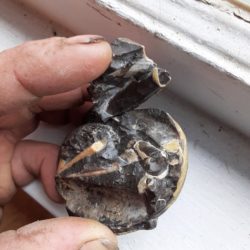-
Curtis Mckibben posted an image in the group
 Bodacious Brachiopods from the myFOSSIL app 2 years, 10 months ago 2 years, 10 months ago2 years, 10 months ago
Bodacious Brachiopods from the myFOSSIL app 2 years, 10 months ago 2 years, 10 months ago2 years, 10 months agothis is other side of fossil that shows a large tooth mark.a tooth still in it and 1 im holding with my fingers.with in 6 feet where i found this was a jawbone that has teeth still in it that look like what did this .amazing .ive posted the jawbone its just a cool as this #fossil

There weren’t many animals that ate ammonites, mainly ichthyosaurs and mosasaurs. The tooth is preserved strangely, I’m not even sure if it is a tooth at all. But if it is, it is most likely a ichthyosaur tooth.
did you see the jaw bone and teeth i posted .they were found within in 6 feet of each other .and your right about what was avail to eat the ammonite and those 2 option u named are what i put my money on and trust me those are teeth
Greetings @curtis-mckibben ! Did you also find this specimen in Spokane as with your jaw segment? I have reservations with the tooth ID. The lithology around Spokane is incredibly complex and consists of igneous and metamorphic rocks. There are considerable Pleistocene sedimentary deposits. The Miocene Latah Formation also makes an appearance in Spokane as well. My concern is that your specimen might be an igneous rock with mineral intrusions over a fossil.
no eastern montana
you should look at my other post of this ammonite .its the other side of it and i assure u its not a igneous rock .
Would you mind sharing the location data of where you discovered it? County and nearest municipality would more than suffice. Knowing the location would go a long way in contextual your specimen in its proper geological formation.
Alright. I see. I didn’t know this was the bottom side of the ammonite you posted.
I have to say that I have only seen that kind of iridescent preservation with Bear Paw Formation belemnites near Fort Peck, Montana.
Impressive stuff.
can any of those commenting tell me about the teeth in the jaw bone thats associated with this fossil .why they have crystallized.is this common?
and thank you i love this stuff .and ill reference with my wife about the exact location in montana were .shes from there .
Greetings @curtis-mckibben ! My best answer regarding the crystallization of your specimens is mineral intrusions of things like calcite, silica, or selenite into the fossil . This often occurs when environmental changes occur in the geological matrix in which the fossil is preserved.
The anterior view of your ammonite specimen appears to possess a black chert matrix.